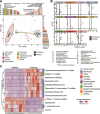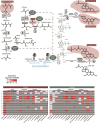Gut microbiota carbon and sulfur metabolisms support Salmonella infections
- PMID: 39404095
- PMCID: PMC11482014
- DOI: 10.1093/ismejo/wrae187
Gut microbiota carbon and sulfur metabolisms support Salmonella infections
Abstract
Salmonella enterica serovar Typhimurium is a pervasive enteric pathogen and ongoing global threat to public health. Ecological studies in the Salmonella impacted gut remain underrepresented in the literature, discounting microbiome mediated interactions that may inform Salmonella physiology during colonization and infection. To understand the microbial ecology of Salmonella remodeling of the gut microbiome, we performed multi-omics on fecal microbial communities from untreated and Salmonella-infected mice. Reconstructed genomes recruited metatranscriptomic and metabolomic data providing a strain-resolved view of the expressed metabolisms of the microbiome during Salmonella infection. These data informed possible Salmonella interactions with members of the gut microbiome that were previously uncharacterized. Salmonella-induced inflammation significantly reduced the diversity of genomes that recruited transcripts in the gut microbiome, yet increased transcript mapping was observed for seven members, among which Luxibacter and Ligilactobacillus transcript read recruitment was most prevalent. Metatranscriptomic insights from Salmonella and other persistent taxa in the inflamed microbiome further expounded the necessity for oxidative tolerance mechanisms to endure the host inflammatory responses to infection. In the inflamed gut lactate was a key metabolite, with microbiota production and consumption reported amongst members with detected transcript recruitment. We also showed that organic sulfur sources could be converted by gut microbiota to yield inorganic sulfur pools that become oxidized in the inflamed gut, resulting in thiosulfate and tetrathionate that support Salmonella respiration. This research advances physiological microbiome insights beyond prior amplicon-based approaches, with the transcriptionally active organismal and metabolic pathways outlined here offering intriguing intervention targets in the Salmonella-infected intestine.
Keywords: Microbiome; genome-resolved; lactate; lactic-acid bacteria; metatranscriptomics; murine.
© The Author(s) 2024. Published by Oxford University Press on behalf of the International Society for Microbial Ecology.
Conflict of interest statement
The authors have no competing interests to report.
Figures





Update of
-
Gut microbiome carbon and sulfur metabolisms support Salmonella during pathogen infection.bioRxiv [Preprint]. 2024 Jan 19:2024.01.16.575907. doi: 10.1101/2024.01.16.575907. bioRxiv. 2024. Update in: ISME J. 2024 Jan 8;18(1):wrae187. doi: 10.1093/ismejo/wrae187. PMID: 38293109 Free PMC article. Updated. Preprint.
References
-
- Plumb ID, Brown AC, Stokes EK, et al. Increased Multidrug-Resistant Salmonella enterica I Serotype 4,[5],12:i:- Infections Associated with Pork, United States, 2009–2018—Volume 29, Number 2—February 2023—EID J—CDC. [cited 3 April 2023]; Available from:https://wwwnc.cdc.gov/eid/article/29/2/22-0950_article. - PMC - PubMed
-
- U.S. Department of Agriculture Food Safety and Inspection Service. Salmonella By the Numbers. [cited 3 April 2023]. Available from: http://www.fsis.usda.gov/inspection/inspection-programs/inspection-poult....
-
- World Health Organization. Salmonella (non-typhoidal). [cited 3 February 2021]. Available from:https://www.who.int/news-room/fact-sheets/detail/salmonella-(non-typhoidal).
-
- U.S. Department of Health and Human Services Centers for Disease Control and Prevention . Antibiotic Resistance Threats in the United States, 2019. CDC (U.S.); 2019. [cited 7 November 2023]. Available from:https://stacks.cdc.gov/view/cdc/82532.
MeSH terms
Substances
Grants and funding
LinkOut - more resources
Full Text Sources
Molecular Biology Databases

